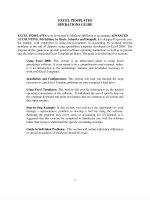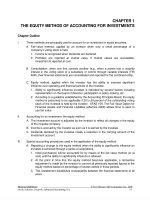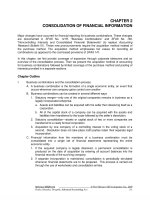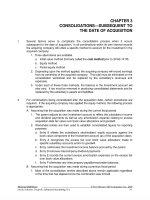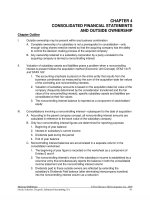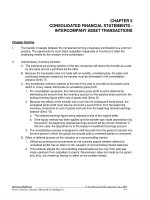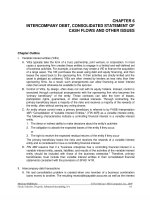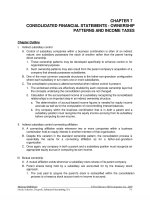Solution manual advanced accounting 2nd by hamlen CH01
Bạn đang xem bản rút gọn của tài liệu. Xem và tải ngay bản đầy đủ của tài liệu tại đây (701.42 KB, 23 trang )
Find more at www.downloadslide.com
CHAPTER 1
SOLUTIONS TO MULTIPLE CHOICE QUESTIONS, EXERCISES AND PROBLEMS
MULTIPLE CHOICE QUESTIONS
1.
c
$180,000 - $160,000 =
$125,000 - $100,000 =
Total gain
2.
$20,000
25,000
$45,000
a
$29,000 - $26,000 = $3,000
3.
a
$207,544 – [(6% x $200,000) – (4% x $207,544)] = $203,846
4.
c
AOCI, beginning balance
Reclassification of unrealized loss on AFS securities sold
Unrealized gain on AFS securities held at year-end (1)
AOCI, ending balance
$ 4,000 credit
1,000 credit
6,000 credit
$11,000 credit
(1) $81,000 – ($100,000 - $25,000) = $6,000 unrealized gain
5.
d
$5,000,000 + 40% x ($600,000 - $200,000) = $5,160,000
6.
b
Solutions Manual, Chapter 1
©Cambridge Business Publishers, 2013
1
Find more at www.downloadslide.com
7.
b
Reported net income 35% x $7,000,000 =
Less unconfirmed profit on ending inventory
35% x [$6,000,000 – ($6,000,000/1.25)] =
Equity in net income for 2014
Less dividends 35% x $2,000,000
Plus beginning investment balance
Ending investment balance
8.
$ 2,450,000
(420,000)
$ 2,030,000
(700,000)
50,000,000
$51,330,000
d
Fizzy’s entry to record the acquisition is:
Current assets
Property
Goodwill
25,000
2,500,000
25,475,000
Liabilities
Cash
9.
b
10.
a
©Cambridge Business Publishers, 2013
2
3,000,000
25,000,000
Advanced Accounting, 2nd Edition
Find more at www.downloadslide.com
EXERCISES
E1.1
Investment in Trading Securities
(in millions)
a.
$209 + 3 = $212
b.
Unrealized gains and losses on trading securities are reported in income.
c.
Investment in trading securities
212
Cash
212
Unrealized losses (income)
3
Investment in trading securities
3
d.
Cash
215
Investment in trading securities
Realized gains (income)
E1.2
209
6
Investment in Available-for-Sale Securities
(in millions)
a.
Impairment loss (income)
26
OCI
Investment in AFS securities
19
7
If the original cost of the securities was $150, and the impairment loss is $26, then the
current fair value of the securities is $150 - $26 = $124. The credit to Investment reduces
the fair value from $131 to $124. The credit to OCI is the amount of unrealized loss
recategorized to income (= $150 - $131).
b.
Investment in AFS securities
83
Unrealized gains (OCI)
83
$83 = $102 - $19.
c.
Cash
Unrealized gains (OCI)
55
6
Investment in AFS securities
Realized gain on AFS securities
(income)
Solutions Manual, Chapter 1
50
11
©Cambridge Business Publishers, 2013
3
Find more at www.downloadslide.com
E1.3
Held-to-Maturity Investments
Amortization schedule (supports numbers in entries below)
Interest income
Amortization
Investment balance
(4% x beginning
($250,000 – interest (beginning balance
investment balance)
income)
– amortization)
1/1/2013
$5,222,591
12/31/2013
$208,904
$41,096
5,181,495
12/31/2014
207,260
42,740
5,138,755
12/31/2015
205,550
44,450
5,094,305
12/31/2016
203,772
46,228
5,048,077
12/31/2017
201,923
48,077
5,000,000
January 1, 2013
Investment in HTM securities
5,222,591
Cash
December 31, 2013
Cash
5,222,591
250,000
Investment income
Investment in HTM securities
December 31, 2014
Cash
208,904
41,096
250,000
Investment income
Investment in HTM securities
December 31, 2015
Cash
207,260
42,740
250,000
Investment income
Investment in HTM securities
December 31, 2016
Cash
205,550
44,450
250,000
Investment income
Investment in HTM securities
December 31, 2017
Cash
203,772
46,228
250,000
Investment income
Investment in HTM securities
Cash
5,000,000
Investment in HTM securities
©Cambridge Business Publishers, 2013
4
201,923
48,077
5,000,000
Advanced Accounting, 2nd Edition
Find more at www.downloadslide.com
E1.4
Investment in Trading, AFS and HTM Securities
Income statement
Investment gains
Investment losses
Interest income
Balance sheet
Assets
Investments-trading
Investments-AFS
Investments-HTM
Equity
AOCI gains (losses)
2012
2013
$ 10,000
(20,000)
$ 25,000
380,000
640,000
40,000
2014
7,778
$ (40,000)
7,849
510,000
196,227
535,000
198,076
(90,000)
35,000
Amortization schedule for HTM investment (supports balances above)
Interest income
Amortization
Investment balance
(4% x beginning
(Interest income (Beginning balance
investment balance)
$6,000)
+ amortization)
1/2/2013
$194,449
12/31/2013
$7,778
$1,778
196,227
12/31/2014
7,849
1,849
198,076
E1.5
Equity Method Investment with Intercompany Sales and Profits
Calculation of 2013 equity in Coca-Cola FEMSA’s net income:
Coca-Cola’s share of Coca-Cola FEMSA’s reported income (32% x $5 million)
+ Realized profit on intercompany sales (32% x ($1,350,000 – ($1,350,000/1.35)))
- Unrealized profit on intercompany sales (32% x ($1,215,000 – ($1,215,000/1.35)))
Equity in net income of Coca-Cola FEMSA
Entry to record equity in Coca-Cola FEMSA’s net income:
Investment in Coca-Cola FEMSA
Equity in income of Coca-Cola
FEMSA
Solutions Manual, Chapter 1
$1,600,000
112,000
(100,800)
$1,611,200
1,611,200
1,611,200
©Cambridge Business Publishers, 2013
5
Find more at www.downloadslide.com
E1.6
Equity Method Investment with Cost in Excess of Book Value
Analysis of acquisition cost (not required):
Acquisition cost
40% x book value
Excess of fair value over book value:
Patents (40% x $4,000,000)
Technology (40% x $1,000,000)
Goodwill
$5,000,000
$2,400,000
1,600,000
400,000
4,400,000
$ 600,000
Calculation of 2013 equity in Ronco’s net income:
Revco’s share of Ronco’s reported income (40% x $900,000)
- Amortization of patent undervaluation ($1,600,000/10)
- Amortization of unreported technology ($400,000/5)
Equity in net income of Ronco
$ 360,000
(160,000)
(80,000)
$ 120,000
Revco’s entries for 2013:
January 1, 2013
Investment in Ronco
5,000,000
Cash
During 2013
Cash
5,000,000
100,000
Investment in Ronco
December 31, 2013
Investment in Ronco
120,000
Equity in net income of Ronco
©Cambridge Business Publishers, 2013
6
100,000
120,000
Advanced Accounting, 2nd Edition
Find more at www.downloadslide.com
E1.7
Equity Method and Other Comprehensive Income
Calculation of 2014 equity in net income:
Share of reported net income (25% x $900,000)
-Amortization of intangibles (25% x $2,000,000/4)
Equity in net income
Journal entries for 2014:
Investment in Turner
$225,000
(125,000)
$100,000
6,000,000
Cash
6,000,000
Investment in Turner
100,000
Equity in income of Turner
Cash
100,000
60,000
Investment in Turner
OCI
60,000
7,500
Investment in Turner
E1.8
7,500
Equity Method Investment Cost Computation
Changes in the investment balance in 2012, 2013, and 2014:
40% reported net income
Amortization of unreported
intangibles (40% x $4,000,000/5)
Equity in net income
Less 40% dividends
Change in investment balance
2012
$ 480,000
2013
$ 600,000
2014
$ 560,000
(320,000)
$ 160,000
(80,000)
$ 80,000
(320,000)
$ 280,000
(100,000)
$ 180,000
(320,000)
$ 240,000
(92,000)
$ 148,000
Total increase in investment balance = $80,000 + $180,000 + $148,000 = $408,000
January 2, 2012 investment cost = $14,608,000 – $408,000 = $14,200,000
Solutions Manual, Chapter 1
©Cambridge Business Publishers, 2013
7
Find more at www.downloadslide.com
E1.9
Joint Venture
(in millions)
Each investor reports the investment on its December 31, 2014 balance sheet at $2,800,000
(= $2,500,000 + 50% x $600,000).
Each investor reports equity in the joint venture’s net income at $300,000 on its 2014 income
statement.
The individual assets and liabilities of the joint venture are not reported separately by the
venturers.
E1.10 Equity Method Investment with Indefinite Life Intangibles Several Years Later
Calculation of 2013 equity in Taylor’s net income:
Saxton’s share of Taylor’s reported income (25% x $250,000)
- Depreciation of plant and equipment (25% x $1,800,000/15)
Equity in net income of Taylor
$ 62,500
(30,000)
$ 32,500
Note: There is no amortization of the customer database because its life is over. The equity
method does not report impairment losses on indefinite life intangibles.
Saxton’s entries for 2013:
During 2013
Cash
25,000
Investment in Taylor
December 31, 2013
Investment in Taylor
32,500
Equity in net income of Taylor
©Cambridge Business Publishers, 2013
8
25,000
32,500
Advanced Accounting, 2nd Edition
Find more at www.downloadslide.com
E1.11 Statutory Merger and Stock Investment (see related E1.10)
(in millions)
a.
Current assets
Plant and equipment
Customer database
Brand names
Goodwill
10.0
51.8
.5
1.5
4.2
Current liabilities
Long-term debt
Cash
16
40
12
b.
Investment in Taylor
12
Cash
12
E1.12 Statutory Merger
(in millions)
Current assets
Plant and equipment
Intangibles
Goodwill
10
40
25
23
Current liabilities
Long-term debt
Cash
Solutions Manual, Chapter 1
12
36
50
©Cambridge Business Publishers, 2013
9
Find more at www.downloadslide.com
PROBLEMS
P1.1
Investments in Marketable Securities
a.
3/5/13
Investment in trading security A
350,000
Cash
350,000
6/3/13
Cash
Loss on sale of trading securities
(income)
325,000
25,000
Investment in trading
security A
350,000
7/14/13
Investment in trading security B
225,000
Cash
225,000
8/2/13
Investment in AFS security D
175,000
Cash
175,000
11/20/13
Investment in AFS security E
300,000
Cash
300,000
12/31/13
Investment in trading security B
27,000
Unrealized gain on trading
securities (income)
Unrealized loss on AFS securities
(OCI)
27,000
50,000
Investment in AFS security E
Investment in AFS security D
15,000
Unrealized gain on AFS
securities (OCI)
©Cambridge Business Publishers, 2013
10
50,000
15,000
Advanced Accounting, 2nd Edition
Find more at www.downloadslide.com
P1.1
continued
a.
continued
1/15/14
Cash
Realized loss on trading
securities (income)
235,000
17,000
Investment in trading
security B
4/2/14
Cash
252,000
213,000
Investment in AFS security D
Realized gain on AFS
securities (income)
Unrealized gain on AFS
securities (OCI)
190,000
23,000
15,000
Realized gain on AFS
securities (income)
4/6/14
Investment in AFS security F
15,000
710,000
Cash
710,000
9/1/14
Investment in trading security C
400,000
Cash
400,000
12/31/14
Investment in trading security C
10,000
Unrealized gain on trading
securities (income)
Unrealized loss on AFS
securities (OCI)
10,000
35,000
Investment in AFS security E
Unrealized loss on AFS
securities (OCI)
20,000
Investment in AFS security F
Solutions Manual, Chapter 1
35,000
20,000
©Cambridge Business Publishers, 2013
11
Find more at www.downloadslide.com
P1.1
continued
b.
2013 Financial Statements
Balance Sheet, 12/31/13
Assets:
Investments in securities
($225,000 + 175,000 + 300,000 + 27,000 – 50,000 + 15,000)
$
Equity:
AOCI
35,000 loss (dr)
Income Statement, 2013
Realized loss
Unrealized gain
Net change in income
$
2014 Financial Statements
Balance Sheet, 12/31/14
Assets:
Investments in securities ($692,000 – 252,000 – 190,000 + 710,000
+ 400,000 + 10,000 – 35,000 – 20,000)
$
Equity:
AOCI (–$35,000 – 15,000 – 35,000 – 20,000)
Income Statement, 2014
Realized loss
Realized gain ($23,000 + 15,000)
Unrealized gain
Net change in income
c.
692,000
(25,000)
27,000
2,000 increase
1,315,000
105,000 loss (dr)
$
(17,000)
38,000
10,000
31,000 increase
The valuation of investments on the balance sheet is the same. Each year’s net losses
reported in AOCI on the balance sheet are instead reported on the income statement.
In 2014, $15,000 of the realized gain on sale of AFS securities is not reported in income,
since it was reported in income in 2013. The $55,000 net unrealized loss on AFS
securities recognized at year-end appears on the income statement.
©Cambridge Business Publishers, 2013
12
Advanced Accounting, 2nd Edition
Find more at www.downloadslide.com
P1.1
continued
c.
continued
Summary of gains and losses reported in income (not required):
Classified as
AFS
Classified as
Trading
Change in income if
AFS securities
classified as trading
2013 income
Realized loss
Unrealized gain
Unrealized loss
Change in income
$(25,000)
27,000
–
$ 2,000
$(25,000)
42,000
(50,000)
$(33,000)
$(35,000)
2014 income
Realized loss
Realized gain
Unrealized loss
Unrealized gain
Change in income
$(17,000)
38,000
–
10,000
$ 31,000
$(17,000)
23,000
(55,000)
10,000
$(39,000)
$(70,000)
By classifying the loss securities as AFS, the company delays reporting the losses in
income until the securities are sold.
P1.2
Held-to-Maturity Intercorporate Debt Investments
a.
Bond #1 pays $60,000 per year in interest and $1,000,000 at maturity.
Cash flow
$60,000
$60,000
$60,000
$60,000
$1,060,000
Total price
Present value calculation
$60,000/1.05
$60,000/(1.05)2
$60,000/(1.05)3
$60,000/(1.05)4
$1,060,000/(1.05)5
Present value
$ 57,143
54,422
51,830
49,362
830,538
$1,043,295
Bond #2 pays $20,000 per year in interest and $500,000 at maturity.
Cash flow
$20,000
$20,000
$20,000
$520,000
Total price
Solutions Manual, Chapter 1
Present value calculation
$20,000/1.05
$20,000/(1.05)2
$20,000/(1.05)3
$520,000/(1.05)4
Present value
$ 19,048
18,141
17,277
427,805
$ 482,271
©Cambridge Business Publishers, 2013
13
Find more at www.downloadslide.com
P1.2
continued
a.
continued
Amortization tables to support answers to requirements b, c and d:
Bond #1
Interest income
(5% x beginning
investment balance)
1/1/2011
12/31/2011
12/31/2012
12/31/2013
12/31/2014
12/31/2015
Amortization
($60,000 – interest
income)
$52,165
51,773
51,362
50,930
50,475
$7,835
8,227
8,638
9,070
9,525
Investment balance
(beginning balance
– amortization)
$1,043,295
1,035,460
1,027,233
1,018,595
1,009,525
1,000,000
Bond #2
Interest income
(5% x beginning
investment balance)
1/1/2011
12/31/2011
12/31/2012
12/31/2013
12/31/2014
Amortization
(interest income –
$20,000)
$24,114
24,319
24,535
24,761
$4,114
4,319
4,535
4,761
Investment balance
(beginning balance
+ amortization)
$482,271
$486,385
490,704
495,239
500,000
b.
Bond #1
Bond #2
Total interest income
2011
$ 52,165
24,114
$ 76,279
2012
$ 51,773
24,319
$ 76,092
c.
$1,018,595 + $495,239 = $1,513,834
d.
U.S. GAAP indicates that there must be an “other than temporary” decline in the value of
the security, making it improbable that the bond issuer will be able to make the remaining
interest and principal payments per the bond agreement. Factors indicating impairment
loss relate to the financial health of the bond issuer, such as failure to make payments on
other debts and a significant decline in credit rating.
The December 31, 2014 carrying value for the $1,000,000 bond is $1,009,525. The
impairment loss is $509,525, reported in income.
©Cambridge Business Publishers, 2013
14
Advanced Accounting, 2nd Edition
Find more at www.downloadslide.com
P1.3
Held-to-Maturity Intercorporate Debt Investment, Impairment Losses
a.
Impairment loss
34,000,000
Investments in HTM
securities
34,000,000
The loss appears on Hansen’s income statement.
b.
Find the interest rate X that solves the following equation, where $6,600,000 = 4% x
$165,000,000:
$131,000,000 = $6,600,000/(1.X) + [($6,600,000+165,000,000)]/(1.X)2
X = 17%
c.
Interest revenue for 2011 = 17% x $131,000,000 = $22,270,000
Cash
Investments in HTM
securities
6,600,000
15,670,000
Interest revenue
22,270,000
December 31, 2011 investment balance: $131,000,000 + $15,670,000 = $146,670,000.
d.
Impairment reversals are not reported, per U.S. GAAP.
P1.4
Equity Method Investment Several Years after Acquisition
a.
Calculation of 2014 equity in net income
Better Bottlers’ net income (45% x $2,500,000)
- Amortization of patents and trademarks revaluation (45% x
($10,000,000/10))
- Amortization of brand names (45% x ($9,000,000/15))
Equity in net income of Better Bottlers
Best Beverages’ journal entries for 2014:
Investment in Better Bottlers
Equity in net income of
Better Bottlers
Cash (45% x $650,000)
(450,000)
(270,000)
$ 405,000
405,000
405,000
292,500
Investment in Better Bottlers
Solutions Manual, Chapter 1
$ 1,125,000
292,500
©Cambridge Business Publishers, 2013
15
Find more at www.downloadslide.com
P1.4
continued
b.
Investment balance, January 2, 2011
+ 45% x 2011 to 2014 reported income less dividends (45% x
($25,000,000 – $13,000,000))
– 4 years of revaluation write-offs:
$450,000 x 4
$270,000 x 4
Investment balance, December 31, 2014
$ 30,000,000
5,400,000
(1,800,000)
(1,080,000)
$ 32,520,000
P1.5
Equity Method Investment Several Years after Acquisition
a.
(Calculation of equity in net income for 2012-2013 provided in addition to 2014’s
calculation, for use in requirement c.)
Equity in net income calculation
30% x Seaway’s net income
Write-off of P&E revaluation (30% x $4,000,000/10
each year)
Amortization of intangibles (30% x $6,000,000/2 for
2012 and 2013 only)
2013 ending inventory profit, upstream
(30% x ($925,000 – $925,000/1.25))
2013 ending inventory profit, downstream
(30% x ($420,000 – $420,000/1.2))
2014 ending inventory profit, upstream
(30% x ($625,000 – $625,000/1.25))
2014 ending inventory profit, downstream
(30% x ($696,000 – $696,000/1.2))
Equity in net income
2012-2013
$ 4,200,000
2014
$1,200,000
240,000
120,000
(1,800,000)
(55,500)
55,500
(21,000)
21,000
(37,500)
_______
$ 2,563,500
(34,800)
$ 1,324,200
b.
Investment in Seaway
1,324,200
Equity in income of Seaway
Unrealized loss (OCI)
1,324,200
240,000
Investment in Seaway
Cash
450,000
Investment in Seaway
©Cambridge Business Publishers, 2013
16
240,000
450,000
Advanced Accounting, 2nd Edition
Find more at www.downloadslide.com
c.
Investment, January 1, 2012
+ Equity in net income, 2012-2013
+ Unrealized gains on AFS securities, 2012-2013 (30% x $1 million)
– Dividends, 2012-2013 (30% x $5 million)
+ Equity in net income, 2014
– Unrealized losses on AFS securities, 2014 (30% x $800,000)
– Dividends, 2014 (30% x $1.5 million)
Investment, December 31, 2014
$ 10,000,000
2,563,500
300,000
(1,500,000)
1,324,200
(240,000)
(450,000)
$ 11,997,700
P1.6
Equity Method Investment with Several Assets in Excess of Book Value
a.
Manchester has $500,000/$2 = 250,000 shares outstanding
40% x 250,000 = 100,000 shares acquired
b.
Calculation of 2013 equity in net income (in thousands)
Manchester’s net income (40% x $1,800)
Adjusted for Bristol’s share of revaluation write-offs:
+ Reduction in cost of goods sold (40% x $400) (note 1)
+ Depreciation on revaluation of P&E (40% x $1,400/20) (note 2)
– Amortization of franchises (40% x ($1,000/5))
Equity in Manchester net income
$ 720
160
28
(80)
$ 828
Note 1:Because Manchester uses FIFO, the beginning inventory is completely sold
during the year.
Note 2:Revaluation of P&E = $1,400 decline [= $(4,200 - $1,300) - $1,500]
P1.7
Equity Method Investment, Intercompany Sales
(in thousands)
a.
Since none of the merchandise has been sold to outside parties, all intercompany profits
are unconfirmed.
Calculation of 2014 equity in net income:
Jackson’s net income (40% x $30,000)
– Unconfirmed profit on downstream ending inventory ($65,000 –
($65,000/1.3))x 40%
– Unconfirmed profit on upstream ending inventory ($54,000 –
($54,000/1.35)) x 40%
Equity in Jackson’s net income
Solutions Manual, Chapter 1
$ 12,000
(6,000)
(5,600)
$ 400
©Cambridge Business Publishers, 2013
17
Find more at www.downloadslide.com
P1.7
continued
b.
Sales revenue
Cost of sales
Gross margin
Gross margin %
Harcker Corporation
As reported
Excluding
following U.S. Intercompany
GAAP
Transactions
$ 131,000
$ 66,000
110,000
60,000
$ 21,000
$ 6,000
16%
9%
Jackson Corporation
As reported
Excluding
following U.S. Intercompany
GAAP
Transactions
$ 264,000
$ 210,000
229,000
189,000
$ 35,000
$ 21,000
13%
10%
Both corporations report higher gross margins as a percent of sales when they include
intercompany transactions. One could easily make the argument that these intercompany
sales distort the 2014 financial results, since pricing to outside customers only achieves a
9% or 10% gross margin on sales, while Harcker’s sales to Jackson achieve a 23%
margin [ = ($65,000 – 50,000)/$65,000] and Jackson’s sales to Harcker achieve a 26%
margin [ = ($54,000 – 40,000)/$54,000].
The equity method removes the investor’s share of unconfirmed gross profits on
upstream and downstream merchandise sales in the equity method income accrual, but
does not adjust each company’s reported sales and cost of sales for intercompany
transactions.
Note to instructor: This problem provides an introduction to elimination of unconfirmed
intercompany profits in consolidation, covered in Chapter 6.
©Cambridge Business Publishers, 2013
18
Advanced Accounting, 2nd Edition
Find more at www.downloadslide.com
P1.8
Equity Investments, Various Reporting Methods
(in thousands)
a.
Balance Sheet, December 31, 2013
Current assets
$ 38,6001
Property, net
450,000
Investment in Quarry (AFS)
1,200
Identifiable intangibles
5,000
_____
Total assets
$ 494,800
Current liabilities
Long-term liabilities
Capital stock
Retained earnings
AOCI
Total liabilities and equity
2013 Income Statement
Sales revenue
Investment income
Cost of sales
Operating expenses
Net income
1
$
20,000
200,000
90,000
185,100
(300)
$ 494,800
$ 900,000
100
(750,000)
(140,000)
$ 10,100
$38,600 = $40,000 – $1,500 + $100
b.
Balance Sheet, December 31, 2013
Current assets
$ 34,4001
Property, net
450,000
Investment in Quarry
6,8002
Identifiable intangibles
5,000
Total assets
$ 496,200
Current liabilities
Long-term liabilities
Capital stock
Retained earnings
Total liabilities and equity
2013 Income Statement
Sales revenue
Equity in income of Quarry
Cost of sales
Operating expenses
Net income
1
2
$
20,000
200,000
90,000
186,200
$ 496,200
$ 900,000
1,200
(750,000)
(140,000)
$ 11,200
$34,400 = $40,000 – $6,000 + $400
$6,800 = $6,000 + (40% x $3,000) - (40% x $1,000)
Solutions Manual, Chapter 1
©Cambridge Business Publishers, 2013
19
Find more at www.downloadslide.com
P1.8
continued
c.
Balance Sheet, December 31, 2013
Current assets
$ 31,0001
Property, net
535,000
Identifiable intangibles
5,000
Goodwill
11,0002
Total assets
$ 582,000
Current liabilities
Long-term liabilities
Capital stock
Retained earnings
Total liabilities and equity
2013 Income Statement
Sales revenue
Cost of sales
Operating expenses
Net income
$
23,000
281,000
90,000
188,0003
$ 582,000
$ 960,000
(770,000)
(177,000)
$ 13,000
1
$31,000 = $40,000 – $15,000 + $5,000 + $1,000 (dividends)
$11,000 = $15,000 – $4,000
3
$188,000 = $185,000 + $3,000
2
©Cambridge Business Publishers, 2013
20
Advanced Accounting, 2nd Edition
Find more at www.downloadslide.com
P1.9
Joint Venture
(all amounts in millions)
a.
Current assets
Plant and equipment, net
Investment in Albar Enterprises
Intangibles
Total assets
Current liabilities
Noncurrent liabilities
Capital stock
Retained earnings
Total liabilities and equity
Allen
Corp
$
1.21
150.0
3.02
200.0
$ 354.2
$
14.0
265.0
10.0
65.23
$ 354.2
Barkely
Corp
$ 0.64
65.0
0.55
3.5
$ 69.6
$
0.2
55.0
1.0
13.46
$ 69.6
1
$1.2 = $1.0 + $0.2
$3.0 = $5.0 – (50% x $3.6) - $0.2
3
$65.2 = $67.0 – (50% x $3.6)
4
$0.6 = $0.4 + $0.2
5
$0.5 = $5.0 – (50% x $3.6) - $0.2 - $2.5 impairment loss
6
$13.4 = $17.7 - (50% x $3.6) - $2.5
2
Note to instructor: Albar reported a net loss of $3.6 in 2012 and distributed $0.4 million
in dividends (equity is $6.0 at year-end = $10.0 initial investment $3.6 loss - $0.4 distribution).
b.
Impairment loss = ($5.0 - $1.8 - $0.2) - $0.5 = $2.5
Although Allen and Barkely probably use similar techniques to compute the value of
their investment, considerable judgment is involved in estimating future expected cash
flows, risk, and investment holding period. Strategy and expectations concerning the
investment may differ between the two corporations. Impairment loss is only reported if
the loss is considered to be other than temporary. Allen and Barkely may come to
different conclusions regarding the value of their investment in Albar Enterprises.
Solutions Manual, Chapter 1
©Cambridge Business Publishers, 2013
21
Find more at www.downloadslide.com
P1.10 Balance Sheet after Business Acquisition
Assets
Current assets
Property and equipment
Intangibles
Goodwill
Total assets
1
Wilson Corporation
Balance Sheet (in millions)
Liabilities
$ 15
Current liabilities
560
Long-term debt
50
Total liabilities
221
Equity
Capital stock
Retained earnings
AOCI
___
Total equity
$ 647
Total liabilities and equity
$
27
465
$ 492
$
50
120
(15)
$ 155
$ 647
$22 = $50 – ($5 + $60 + $23 + $7 - $2 – $65)
P1.11 Business Acquisition
( in thousands)
Cash and receivables
Inventory
Plant and equipment
Other tangible assets
Distribution relationships
Trademarks, copyrights and brands
Other identifiable intangible assets
Goodwill
466
142
21
131
715
834
1,961
1,329
Accounts payable
Cash
Common stock
©Cambridge Business Publishers, 2013
22
686
369
4,544
Advanced Accounting, 2nd Edition
Find more at www.downloadslide.com
P1.12 Trading and AFS Investments, Impairment
Cash
43,000
Investment in trading securities
Gain on sale of trading
securities (income)
Cash
40,000
3,000
20,000
Investment in trading securities
Gain on sale of trading
securities (income)
Investment in trading
securities
16,000
4,000
60,000
Cash
Loss on trading securities
(income)
60,000
8,000
Investment in trading securities
Cash
Unrealized gains (OCI)
8,000
52,000
1,000
Investment in AFS securities
Gain on sale of AFS securities
(income)
Investment in AFS
securities
50,000
3,000
3,000
Unrealized gains (OCI)
Impairment loss on AFS
securities (income)
3,000
20,000
Investment in AFS securities
Unrealized losses (OCI)
15,000
5,000
Balance sheet, December 31, 2013
Investment in trading securities…………………………………………… $ 52,000
Investment in AFS securities……………………………………………… 98,000
AOCI (unrealized losses on AFS securities)……………………………… (23,000)
Income statement for 2013
Gains on sale of trading securities……………………………………….... $ 7,000
Gain on sale of AFS securities……………………………………………..
3,000
Unrealized loss on trading securities………………………………………
(8,000)
Impairment loss on AFS securities……………………………………….. (20,000)
Net loss on trading and AFS securities…………………………………… $ (18,000)
Solutions Manual, Chapter 1
©Cambridge Business Publishers, 2013
23


